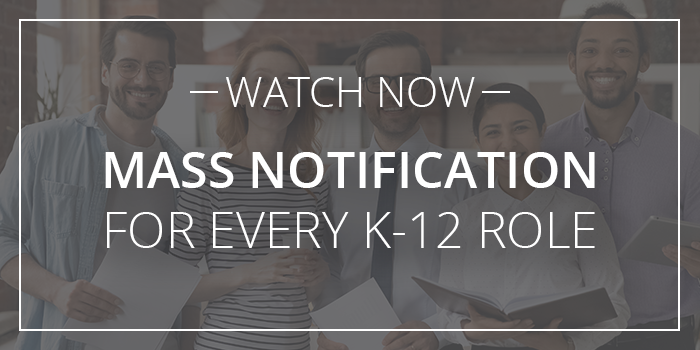Deriving More Value from School Notification Systems
When school districts think of school notification system, they might have a limited view of what these kinds of tools can do and who can use them. We often see principals or superintendents working with their safety teams and local law enforcement to find and implement a system to address safety needs like Alyssa’s Law, but not all schools taking fully leverage what a notification system has to offer. IT, facilities, school office administrators, and even teachers and other staff members can all take advantage of the features available from a school notification system.
Watch the video below to see how everyone in a K-12 school can benefit from a notification system, and keep reading this blog post for more in-depth details.
Principals
Principals need to keep schools running, and that means providing a safe environment for students and staff. School notification systems allow principals to work with other staff members to develop actionable safety plans that can be accessed and activated from anywhere. It also allows them to automate daily tasks like school bells and announcements. This gives them more time to help students and staff and less time worrying about monotonous administrative activities.
Security
With a notification system, school security teams have a powerful solution they can leverage during an incident. Notifications can be activated right from a cell phone to begin protecting students and teachers and coordinating a response. Using virtual collaboration tools and real-time insights, security can assess the situation, know who needs help and deploy assistance to those most in danger.
IT Teams
A school’s IT team will undoubtedly have a hand in setting up and testing a notification system. This includes helping connect different technologies already in place around a school and helping manage alerts to ensure the right people get the right message at the right time. As technology becomes more critical to everyday learning
Office Administrators
Office administrators can monitor for alerts that may impact operations. Desktop notifications can pop up with information that could put students and staff at risk. Automated alerts, like notifications about severe weather, can give advance warnings about potential issues. They can also make school wide pages and alter school bell schedules as needed.
Facility and Maintenance Crews
Environmental threats like a burst pipe or icy sidewalk can impact operations. Being able to send alerts throughout the school can let people know to avoid certain areas until issues are resolved. Automated sensors integrated with a notification system can also let facility and maintenance crews know the moment an accident has occurred so they can respond quickly and minimize damage.
Teachers and Staff
While teachers and staff will have little reason to manage the backend of a school notification system, they can still become knowledgeable users to help address issues in the classroom. Panic buttons configured on a desk phone or a physical panic button installed in a classroom can offer a discreet and immediate way for teachers to request assistance if they have an unruly student they cannot handle on their own. If teachers and staff are outside the classroom, either out at recess or in the lunchroom, mobile apps allow them to trigger alerts the moment they see an issue arise.
The more ways a school can find to leverage a notification system, the more they can enhance safety and communication and get more value out of their investment in it.
